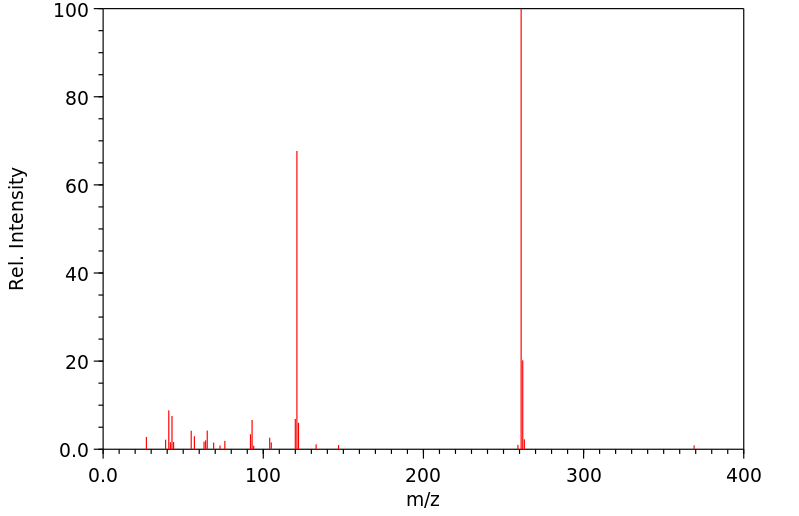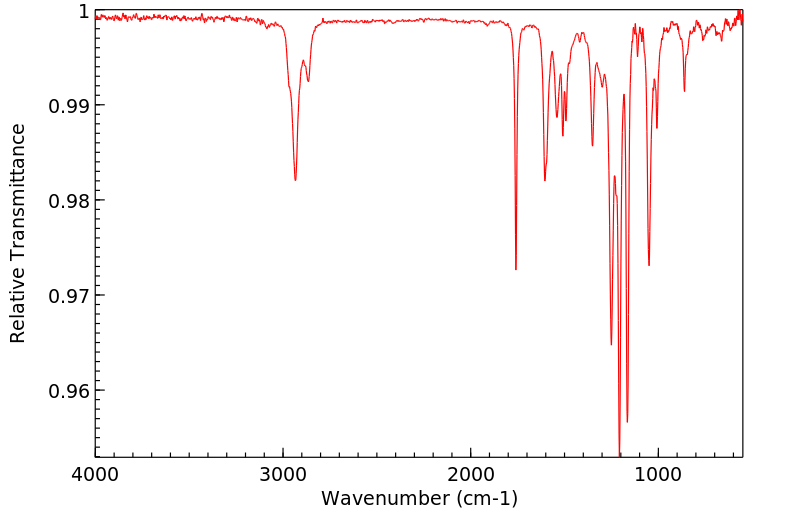4-硝基苯基 4-癸氧基苯甲酸酯 | 63635-84-7
分子结构分类
中文名称
4-硝基苯基 4-癸氧基苯甲酸酯
中文别名
4-硝基苯基4-癸氧基苯甲酸酯
英文名称
4-Nitrophenyl-4'-decyloxybenzoat
英文别名
p-Nitrophenyl p-decyloxybenzoate;(4-nitrophenyl) 4-decoxybenzoate
CAS
63635-84-7
化学式
C23H29NO5
mdl
MFCD00043781
分子量
399.487
InChiKey
SYQHCBATGVPGPV-UHFFFAOYSA-N
BEILSTEIN
——
EINECS
——
-
物化性质
-
计算性质
-
ADMET
-
安全信息
-
SDS
-
制备方法与用途
-
上下游信息
-
文献信息
-
表征谱图
-
同类化合物
-
相关功能分类
-
相关结构分类
计算性质
-
辛醇/水分配系数(LogP):7.8
-
重原子数:29
-
可旋转键数:13
-
环数:2.0
-
sp3杂化的碳原子比例:0.434
-
拓扑面积:81.4
-
氢给体数:0
-
氢受体数:5
安全信息
-
海关编码:2918990090
SDS
上下游信息
-
上游原料
中文名称 英文名称 CAS号 化学式 分子量 4-(癸氧基)苯甲酸 p-decyloxybenzoic acid 5519-23-3 C17H26O3 278.392 4-(癸基氧基)苯甲酸甲酯 methyl 4-decyloxybenzoate 62443-10-1 C18H28O3 292.419
反应信息
-
作为反应物:描述:4-硝基苯基 4-癸氧基苯甲酸酯 在 palladium on activated charcoal 作用下, 以 四氢呋喃 、 乙醇 为溶剂, 生成 4-decyloxybenzoate 4-aminophenol参考文献:名称:在近晶碳和向列相中的13 C NMR的相表征和三环液晶元的分子序研究摘要:由于其对诸如温度,机械力以及电场和磁场之类的外部刺激的敏感性,表现出热致液晶性质的分子已经变得非常重要。结果,通过在芳族核附近以及在侧链中引入各种官能团,已经合成了几种新颖的介晶,并且已经研究了它们的性质。在本研究中,我们报告了在一个末端带有羟基的三环液晶元。这些介晶通过多步路线合成,并通过光谱技术完成结构表征。通过热阶段光学偏振显微镜,差示扫描量热法和小角X射线散射研究了中间相性质。较低的同系物发现了对映向列相,而较高的同系物则发现了另外的近晶C相。固态高分辨率自然丰度已经对固相和中间相中典型的液晶元进行了13 C NMR研究。层列碳相和向列相的液晶元的13 C NMR光谱表明该分子在磁场中自发排列。通过利用称为SAMPI4的二维分离局部场(SLF)NMR实验,获得了13 C– 1 H偶极耦合,这些耦合用于确定液晶元的取向顺序参数。DOI:10.1021/jp203388v
-
作为产物:描述:参考文献:名称:在近晶碳和向列相中的13 C NMR的相表征和三环液晶元的分子序研究摘要:由于其对诸如温度,机械力以及电场和磁场之类的外部刺激的敏感性,表现出热致液晶性质的分子已经变得非常重要。结果,通过在芳族核附近以及在侧链中引入各种官能团,已经合成了几种新颖的介晶,并且已经研究了它们的性质。在本研究中,我们报告了在一个末端带有羟基的三环液晶元。这些介晶通过多步路线合成,并通过光谱技术完成结构表征。通过热阶段光学偏振显微镜,差示扫描量热法和小角X射线散射研究了中间相性质。较低的同系物发现了对映向列相,而较高的同系物则发现了另外的近晶C相。固态高分辨率自然丰度已经对固相和中间相中典型的液晶元进行了13 C NMR研究。层列碳相和向列相的液晶元的13 C NMR光谱表明该分子在磁场中自发排列。通过利用称为SAMPI4的二维分离局部场(SLF)NMR实验,获得了13 C– 1 H偶极耦合,这些耦合用于确定液晶元的取向顺序参数。DOI:10.1021/jp203388v
文献信息
-
Rodlike metallomesogens containing nickel(<scp>ii</scp>), palladium(<scp>ii</scp>) and copper(<scp>ii</scp>) based on novel enaminoketonato ligands作者:Carsten P. Roll、Alexander G. Martin、Helmar Görls、Guido Leibeling、Daniel Guillon、Bertrand Donnio、Wolfgang WeigandDOI:10.1039/b316731c日期:——Several new enaminoketone mesogens were synthesized and coordinated to various metal salts to yield a variety of novel rodlike metal-containing liquid crystals. The mesophases were characterized by polarized optical microscopy (POM), differential scanning calorimetry (DSC) and small-angle X-ray scattering (SAXS). Whereas the free ligands display SmA and nematic mesophases, the NiII and PdII complexes give rise to SmC and nematic phases, and the paramagnetic CuII mesogens to a narrow temperature-range nematic mesophase only. The magnetic behaviour of the latter was studied by means of EPR and magnetic susceptibility (SQUID) measurements.
-
Combined Stabilizing Effects of Trifluoromethyl Groups and Semifluorinated Side Chains on the Thermotropic Liquid‐Crystal Behavior of β‐Enamino Ketone Ligands and Their Bischelate Pd <sup>II</sup> Complexes作者:Alexander Martin、Carolin Mügge、Douglas L. Gin、Bertrand Donnio、Wolfgang WeigandDOI:10.1002/ejic.201402489日期:2014.11β-enamino ketone ligands and their corresponding bischelate PdII complexes bearing various combinations of methyl and trifluoromethyl groups at the chelating center as well as peripheral hydrocarbon and perfluorinated side chains were prepared. The effect of these structural modifications on the thermotropic liquid-crystalline behavior of both the ligands and the corresponding metal complexes was studied
-
Synthesis and mesomorphic properties of novel Schiff base liquid crystalline EDOT derivatives作者:Ashwathanarayana Gowda、Arun Roy、Sandeep KumarDOI:10.1016/j.molliq.2016.11.010日期:2017.1Herein, we reported novel banana liquid crystals derived from ethylenedioxythiophene (EDOT) central unit encompass with Schiff base. Structural charecterization of these compounds was carried out from their spectral and elemental analysis. Physical properties of all the newly synthesized compounds were investigated by polarising optical microscopy, differential scanning calorimetry, thermogravimetric在本文中,我们报道了衍生自席夫碱的亚乙基二氧噻吩(EDOT)中心单元衍生的新型香蕉液晶。这些化合物的结构表征是通过其光谱和元素分析进行的。通过偏光光学显微镜,差示扫描量热法,热重分析,X射线衍射和拉曼光谱研究了所有新合成的化合物的物理性质。带有EDOT的三环Schiff碱弯曲核化合物是非同晶的,但所有包含五环的Schiff碱都表现出对映中间相行为。较高的同系物在较低温度下显示长距离向列相以及近晶C相。而较低的同系物仅显示N相。这些化合物中的弯曲角介于熔融LC和香蕉LC之间。因此,分子从典型弯曲核LC中观察到的极性有序堆积中逸出。XRD的详细研究表明,较低的同源物中存在N相,较高的同源物中存在Sm C相。
-
Effect of hydrogen-bonded supramolecular assembling on liquid crystal properties of imidazole-containing azomethines and their chelates with copper(II)作者:Oleg N. Kadkin、Jigeon Tae、Eun Ho Kim、So Yeon Kim、Moon-Gun ChoiDOI:10.1080/10610270802709386日期:2010.1A series of imidazole-containing rod-like Schiff's bases and their ionic copper(II) chelates with various lengths of the terminal alkyl chain containing 6, 8, 10, 12, 14 and 16 carbon atoms have been synthesised. The synthesised compounds were characterised by elemental analyses, H-1 NMR, IR and UV-vis and mass spectroscopies. Thermotropic smectic C mesophases in the ligands and smectic A mesophases in the copper(II) complexes were identified using POM, DSC and small-angle XRD scattering methods. X-ray diffraction patterns of the prepared imidazole imines indicate to supramolecular self-assembled structures in the liquid crystal state, which are formed by means of intermolecular hydrogen bonds. It was established that both liquid crystal arrangement and supramolecular assemblies in ligands disappeared near 190 degrees C, mainly regardless of the lengths of the terminal alkyl chains. Contrary, assembling of the copper(II) complexes into supramolecular bilayers occurs near 200 degrees C, which causes their transition to a smectic A mesophase.
-
Kaharu, T.; Takahashi, S., Molecular Crystals and Liquid Crystals Science and Technology, Section A: Molecular Crystals and Liquid Crystals, 1994, vol. 257, p. 35 - 42作者:Kaharu, T.、Takahashi, S.DOI:——日期:——
表征谱图
-
氢谱1HNMR
-
质谱MS
-
碳谱13CNMR
-
红外IR
-
拉曼Raman
-
峰位数据
-
峰位匹配
-
表征信息
同类化合物
非那米柳
雷尼替丁
降钙素(humanreduced),8-L-缬氨酸-(9CI)
间苯甲酰氧基苯乙酮
间苯二甲酸二苯酯
间甲苯基苯甲酸酯
间双没食子酸
醋氨沙洛
邻苯二甲酸苄酯2-乙己基酯
邻苯二甲酸二苯酯-D4
邻苯二甲酸二苯酯
邻甲苯基苯甲酸酯
邻氨基苯甲酸(4-硝基苯基)酯
邻亚苯基二苯甲酸酯
贝诺酯
袋衣酸
血竭黄烷A
萘-1,5-二磺酸-4-[2-(二甲氨基)乙氧基]-2-甲基-5-(丙烷-2-基)苯基2-氨基苯酸酯(1:1)
茶痂衣酸
苯酚,2-[2-[(4-氯苯基)氨基]-4-噻唑基]-,苯酸酯(ester)
苯甲醯柳酸甲酯
苯甲酸苯酯
苯甲酸五氟苯酯
苯甲酸丁香酚酯
苯甲酸4-[[(4-甲氧基苯基)亚甲基]氨基]苯基酯
苯甲酸4-(乙酰氨基)-2-[[2-[4-(乙酰氨基)苯甲酰基]亚肼基]甲基]苯基酯
苯甲酸2-(2-苯并恶唑基)苯酯
苯甲酸-4-甲基苯酯
苯甲酸-(4-环戊基-苯基酯)
苯甲酸-(2-烯丙基-4-溴-苯基酯)
苯甲酸-(2-溴-4,6-二硝基-苯基酯)
苯甲酸-(2,4-二溴-3-甲基-苯基酯)
苯甲酸-(2,4-二氯-5-甲基-苯基酯)
苯甲酸-(2,4-二叔丁基苯基酯)
苯甲酸,4-羟基-,4-[(4-羟基苯氧基)羰基]苯基酯
苯甲酸,4-羟基-,4-(己氧基)苯基酯
苯甲酸,4-羟基-,4-(十四烷氧基)苯基酯
苯甲酸,4-羟基-,4-(十二烷氧基)苯基酯
苯甲酸,4-甲酰基-,4-(辛氧基)苯基酯
苯甲酸,4-甲氧基-,2-甲酰基苯基酯
苯甲酸,4-甲基-,4-甲基苯基酯
苯甲酸,4-戊基-,4-(壬氧基)苯基酯
苯甲酸,4-丁氧基-,1,4-亚苯基酯
苯甲酸,4-[[[3-[(2,2-二甲基-1-羰基丙氧基)甲基]-3,4-二氢-2-甲基-4-羰基-6-喹唑啉基]甲基]-2-炔丙基氨基]-,五氟苯基酯
苯甲酸,4-[1-(己氧基)乙基]-,4-(辛氧基)苯基酯
苯甲酸,4-(辛氧基)-,4-[[4-[[(1-甲基庚基)氧代]羰基]苯基]乙炔基]苯基酯
苯甲酸,4-(苯基甲氧基)-,4-(癸氧基)苯基酯
苯甲酸,4-(苯基甲氧基)-,4-(壬氧基)苯基酯
苯甲酸,4-(苯基甲氧基)-,4-(十二烷氧基)苯基酯
苯甲酸,4-(癸氧基)-,4-[氰基[(1-羰基戊基)氧代]甲基]苯基酯,(R)-








